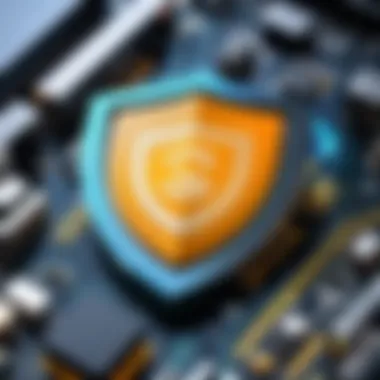Unlocking the Power of Remote Mobile Device Management (MDM) for Enhanced Cybersecurity


Overview of Cyber Security Threats
In the current digital landscape, the prevalence of cyber threats poses a significant risk to individuals and organizations worldwide. Malicious entities employ various tactics such as malware, phishing, and ransomware to exploit vulnerabilities in systems and networks, compromising sensitive data and financial assets. These cyber threats continue to evolve, becoming more sophisticated and challenging to detect. By understanding the types of cyber threats and studying real-life examples of security breaches, individuals can fortify their defenses and mitigate potential risks. Stay vigilant, as cyber attacks can target anyone at any time.
Best Practices for Online Security
To bolster online security defenses, incorporating best practices is paramount. Establishing strong password creation techniques and diligently managing passwords is the first line of defense against unauthorized access. Regular software updates and patches are vital to address existing vulnerabilities and enhance system resilience. Implementing two-factor authentication adds an extra layer of protection, augmenting the security posture of individuals and organizations. By adhering to these best practices, users can mitigate the risks associated with cyber threats and safeguard their digital assets.
Reviews of Security Tools
Amidst the cybersecurity realm, the efficacy of security tools plays a crucial role in combatting online threats. Evaluating the effectiveness of antivirus software, comparing different firewall protection mechanisms, and assessing the reliability of password managers are essential steps in fortifying defenses. Each security tool serves a unique purpose, contributing to the holistic protection of digital assets. It is imperative to choose reliable and reputable security tools to ensure comprehensive safeguarding against cyber threats. Stay informed about the latest developments in security technologies to stay ahead of potential risks.
Tips for Ensuring Online Privacy
Maintaining online privacy is equally significant in the digital age, where personal information is at risk of exploitation. Using Virtual Private Networks (VPNs) for secure browsing establishes encrypted connections, shielding data from prying eyes. Adjusting privacy settings on social media platforms restricts the distribution of personal information to unauthorized parties. When engaging in online transactions, safeguarding personal data is essential to prevent identity theft and fraud. Implementing these tips enhances online privacy and mitigates the potential risks associated with data breaches and unauthorized access.
Educational Resources and Guides
Empowering individuals with knowledge and resources is key to fostering a secure online environment. Accessing how-to articles on setting up encryption tools, following step-by-step guides on identifying phishing emails, and utilizing cheat sheets for enhancing online security practices are valuable resources in combating cyber threats. Education is a proactive measure in building resilience against potential risks, equipping individuals with the necessary skills to navigate the digital landscape securely. Stay informed, stay vigilant, and prioritize cybersecurity in all online endeavors.
Preamble to Remote Mobile Device Management ()
Remote Mobile Device Management (MDM) stands at the forefront of cybersecurity measures in today's digital landscape, ensuring the protection of vital data for individuals and organizations alike. This section delves into the intricacies of MDM, shedding light on its paramount significance in safeguarding against potential cyber threats. By comprehensively exploring the landscape of Remote MDM, readers will grasp its multifaceted functionalities, benefits, and essential considerations to fortify their cybersecurity posture.
Defining Remote
The Conceptual Framework of Remote
The Conceptual Framework of Remote MDM delineates the underlying structure and principles that guide remote device management operations. Its emphasis on proactively monitoring and controlling mobile devices remotely is crucial for efficient cybersecurity management. The flexibility and scalability offered by this framework make it a compelling choice for bolstering security measures. However, the intricacies of implementation and maintenance can pose challenges but are outweighed by the benefits of heightened security protocols.
Key Objectives of Remote
The Key Objectives of Remote MDM crystalize the central goals of comprehensive device management, focusing on optimizing security measures and enhancing operational efficiency. By prioritizing data security and streamlined device monitoring, Remote MDM aims to provide a robust defense against cyber threats while facilitating seamless organizational operations. The emphasis on customization and adaptability underscores its advantage in aligning with diverse user needs and organizational requirements, although balancing flexibility with stringent security measures remains a perpetual consideration.
Importance of Remote Mobile Device Management
Enhancing Cybersecurity Posture


Enhancing Cybersecurity Posture through Remote MDM is pivotal in fortifying defenses against evolving cyber threats, safeguarding sensitive information from potential breaches. With a proactive approach to threat detection and mitigation, Remote MDM plays a crucial role in preempting cyber attacks and ensuring data integrity. However, the complexity of cybersecurity frameworks and potential interoperability issues present challenges that require diligent oversight and management.
Securing Confidential Data
Securing Confidential Data underscores the paramount importance of data protection in an increasingly digital world. Remote MDM enables organizations to implement robust encryption measures and secure data transmission channels, ensuring the confidentiality and integrity of sensitive information. Despite its efficacy in data security, the intricacies of data encryption and key management pose operational challenges that necessitate continuous monitoring and intervention.
Evolution of Remote
From Traditional to Remote Solutions
The transition from Traditional MDM to Remote Solutions marks a paradigm shift in device management strategies, leveraging remote capabilities to enhance accessibility and operational efficiency. By facilitating real-time device monitoring and seamless updates, Remote MDM optimizes system performance while minimizing manual intervention. The scalability and agility afforded by remote solutions offer unparalleled advantages, yet the integration complexities and potential network vulnerabilities demand stringent oversight and proactive measures.
Impact of Remote Work Trends
The Impact of Remote Work Trends on Mobile Device Management underscores the increasing reliance on remote solutions to accommodate decentralized work environments. Remote MDM plays a pivotal role in ensuring device security and data privacy amidst the proliferation of remote work practices. Although remote work trends enhance flexibility and productivity, they also introduce new challenges in information security and data governance that organizations must proactively address to maintain robust cybersecurity measures.
Features and Benefits of Remote
Remote Mobile Device Management (MDM) plays a pivotal role in modern cybersecurity landscapes. It offers a comprehensive approach to monitoring and securing mobile devices used by individuals and organizations. The features and benefits of Remote MDM are multifaceted, ranging from real-time tracking capabilities to enhanced security protocols. In this article, we delve into the essence of Remote MDM, shedding light on its significance in fortifying digital defenses and ensuring data integrity.
Comprehensive Device Monitoring
Comprehensive device monitoring forms the backbone of Remote MDM solutions. Within this realm, two key aspects stand out: real-time tracking capabilities and application usage insights.
Real-time Tracking Capabilities
Real-time tracking capabilities empower administrators to monitor device activities instantaneously. This feature enables immediate response to any suspicious behavior or security breaches, contributing to the overall proactive security posture. The unique selling point of real-time tracking lies in its ability to provide up-to-the-minute visibility into device locations and actions, enhancing the responsiveness to potential threats.
Application Usage Insights
Application usage insights offer valuable data on how mobile applications are utilized within an organization. This feature aids in identifying data breach risks, unusual activity patterns, or unauthorized software usage. By analyzing application usage insights, administrators can fine-tune security policies and ensure compliance with company regulations, making it a crucial element in the Remote MDM toolkit.
Enhanced Security Protocols
A robust security framework is indispensable in the realm of Remote MDM. Enhanced security protocols encompass data encryption measures and remote locking and wiping functionalities.
Data Encryption Measures
Data encryption measures safeguard sensitive information stored on mobile devices. By encrypting data at rest and in transit, organizations can mitigate the risk of unauthorized access and data leaks. The primary advantage of data encryption is its ability to render intercepted information unreadable, thus ensuring confidentiality and compliance with data protection regulations.


Remote Locking and Wiping
Remote locking and wiping feature empowers administrators to remotely lock a device or wipe its data in case of loss or theft. This capability acts as a failsafe measure to prevent unauthorized access to confidential data, reducing the potential impact of security incidents. While offering peace of mind, remote locking and wiping also pose challenges in terms of data recovery and user convenience.
Streamlined Configuration Management
Efficient configuration management streamlines device operations within Remote MDM solutions. This segment encompasses automated updates and policies alongside uniform device settings.
Automated Updates and Policies
Automated updates and policies ensure that devices are consistently updated with the latest security patches and configurations. This automation minimizes the risk of human error and enhances operational efficiency, promoting a uniform security posture across all managed devices. The unique feature of automated updates lies in its ability to deploy patches promptly, reducing vulnerabilities and ensuring device compliance with security standards.
Uniform Device Settings
Uniform device settings establish a standardized environment across all managed devices. By enforcing uniform configurations, organizations can maintain security consistency and operational continuity. The key advantage of uniform device settings is the simplification of device management tasks and the reduction of complexities associated with varied settings. However, striking a balance between standardization and individual user preferences can be a daunting task for administrators.
Implementation Strategies for Remote
In this article, the focus shifts towards Implementation Strategies for Remote MDM, a critical aspect in the realm of mobile device management. These strategies play a pivotal role in ensuring the successful deployment and operation of remote MDM solutions. By delving into the nuances of Implementation Strategies, readers will grasp the importance of meticulous planning and execution in the context of remote MDM. The effectiveness of remote MDM systems heavily relies on well-thought-out implementation strategies that cater to the specific needs and challenges of modern cybersecurity landscapes.
Choosing the Right Remote Solution
Evaluating Security Features
Exploration into the realm of Evaluating Security Features within Remote MDM solutions unravels a crucial aspect of system selection. Security features act as the bedrock of any MDM solution, determining the level of protection it can offer against emerging cyber threats. The ability to scrutinize security features not only enhances the overall cybersecurity posture but also ensures the resilience of remote MDM infrastructure. A key characteristic of impactful security features lies in their capacity to adapt to dynamic threat landscapes, providing proactive defense mechanisms that shield devices and data effectively. By prioritizing solutions with robust security features, organizations can fortify their cybersecurity defenses and mitigate potential risks effectively.
Scalability and Customization Options
As organizations navigate the complexities of modern cybersecurity challenges, the significance of Scalability and Customization Options within Remote MDM solutions becomes apparent. The ability to scale resources and customize functionalities according to organizational requirements is paramount in ensuring the seamless integration of remote MDM systems. Scalability enables organizations to expand their MDM infrastructure as needed, accommodating growth and evolving security demands. Furthermore, customization options empower organizations to tailor their remote MDM solutions to align with specific security policies and regulatory requirements, enhancing operational efficiency and regulatory compliance. Leveraging scalable and customizable MDM solutions equips organizations with the adaptability and versatility required to address the dynamic nature of cybersecurity threats.
Integration with Existing IT Infrastructure
Seamless Deployment Processes
The integration of Remote MDM solutions with existing IT infrastructure introduces a myriad of benefits, with Seamless Deployment Processes standing out as a key facilitator. Seamless deployment processes streamline the incorporation of MDM solutions into the organization's IT ecosystem, minimizing disruptions and optimizing operational efficiency. A key characteristic of seamless deployment lies in its ability to seamlessly integrate with diverse IT environments, regardless of complexity or scale. By prioritizing solutions that offer seamless deployment processes, organizations can expedite the implementation of remote MDM systems, accelerating time-to-value and maximizing the effectiveness of cybersecurity measures.
Alignment with Employee Usage Patterns


Aligning Remote MDM solutions with employee usage patterns is essential in fostering user adoption and compliance within organizations. By understanding and accommodating employee behaviors and preferences, organizations can optimize the user experience and enhance overall productivity. A key characteristic of aligning with employee usage patterns is the ability to balance security protocols with user convenience, ensuring a harmonious relationship between security measures and employee workflows. By integrating MDM solutions that align with employee usage patterns, organizations can cultivate a security-conscious culture while promoting seamless collaboration and productivity.
Training and Adoption Initiatives
Employee Education on Remote
Educating employees on the nuances of Remote MDM is pivotal in ensuring the successful implementation and utilization of MDM solutions. Employee education enhances awareness regarding cybersecurity best practices, data handling procedures, and the importance of adhering to MDM policies. A key characteristic of effective employee education lies in its ability to empower employees with the knowledge and skills to leverage MDM solutions securely. By investing in comprehensive training programs, organizations can instill a culture of security awareness, equipping employees with the necessary tools to mitigate risks and safeguard sensitive information.
Incentivizing Compliance and Best Practices
Incentivizing compliance and best practices among employees serves as a proactive approach to enhancing cybersecurity within organizations. By incentivizing adherence to MDM policies and security protocols, organizations can motivate employees to prioritize cybersecurity measures in their day-to-day activities. A key characteristic of incentivizing compliance and best practices is the reinforcement of desired behaviors through rewards, recognition, or gamification strategies. By creating a culture that values cybersecurity vigilance and compliance, organizations can significantly reduce the likelihood of security incidents and data breaches, safeguarding critical assets and maintaining operational continuity.
Challenges and Future Trends in Remote
In the realm of Remote Mobile Device Management (MDM), the discussion around Challenges and Future Trends holds paramount importance. As technology advances at a rapid pace, staying ahead of potential threats and embracing upcoming trends is key to maximizing cybersecurity efforts. Addressing these challenges proactively can lead to stronger defense mechanisms and improved data protection strategies. Future trends, on the other hand, offer insights into what lies ahead in the landscape of remote MDM, allowing organizations and individuals to adapt and grow in alignment with evolving technological landscapes.
Addressing Data Privacy Concerns
GDPR Compliance Regulations
Within the domain of Remote MDM, GDPR Compliance Regulations stand as a cornerstone in ensuring data privacy and security. Understanding the intricacies and requirements of GDPR can significantly enhance compliance efforts, thereby fortifying overall data protection measures. The key characteristic of GDPR lies in its stringent guidelines regarding data handling and user consent, making it a popular choice for bolstering security frameworks. The unique feature of GDPR compliance is its emphasis on transparency and accountability, offering advantages such as increased trust among users and the mitigation of data breaches. However, challenges may arise in the complexities of implementation and the need for continuous monitoring to maintain compliance standards.
Cultural Perspectives on Data Monitoring
Cultural Perspectives on Data Monitoring bring a nuanced approach to the data privacy discussion within Remote MDM. Recognizing and respecting cultural differences in how data privacy is perceived and valued can greatly influence policy-making and user interactions. The key characteristic of cultural perspectives is the shift from a universal approach to one that considers individual values and societal norms, making it a beneficial addition to this article. The unique feature of cultural perspectives is the personalized insights it offers into user behaviors and preferences, which can inform targeted data protection strategies. However, challenges may arise concerning the adaptation of global policies to diverse cultural contexts and the potential for misinterpretation or resistance within certain communities.
AI Integration and Predictive Analysis
Utilizing AI for Threat Detection
The integration of AI for threat detection marks a significant advancement in Remote MDM practices, allowing for real-time analysis and proactive threat mitigation. The key characteristic lies in AI's ability to process vast amounts of data swiftly and accurately, making it a popular choice for enhancing cybersecurity measures. AI's unique feature in threat detection is its adaptive nature, continually learning and evolving to stay ahead of emerging risks. This offers advantages such as precise threat identification and rapid response times. However, challenges may surface in ensuring AI algorithms remain unbiased and transparent, along with the need for continual updates to address evolving threats.
Incorporating Predictive Analytics for Risk Mitigation
Incorporating Predictive Analytics for Risk Mitigation introduces a proactive approach to cybersecurity within Remote MDM frameworks. By analyzing patterns and trends, predictive analytics can foresee potential risks and vulnerabilities, enabling preemptive actions. The key characteristic of predictive analytics is its focus on future outcomes based on existing data, making it a valuable choice for risk management. The unique feature lies in its ability to offer foresight into upcoming threats, assisting in forming robust defense strategies. However, challenges may arise in data accuracy and interpretation, as well as the need for skilled personnel to utilize predictive insights effectively.
IoT and BYOD Implications
Securing IoT Devices under Remote
Securing IoT Devices under Remote MDM is crucial in the age of interconnected smart devices, where vulnerabilities can lead to extensive security breaches. The key characteristic of this aspect is the diverse nature of IoT devices and the varying security protocols they require, making it a challenging yet essential choice for enhancing overall security measures. The unique feature is the integration of IoT management within MDM platforms, streamlining control and monitoring processes for a wide array of devices. This offers advantages such as centralized security oversight and holistic threat protection. However, challenges may arise in ensuring compatibility across multiple IoT devices and the ongoing need for system updates and patches.
Managing the Diversity of BYOD Policies
Managing the Diversity of BYOD Policies addresses the complexities of balancing employee mobility with data security within Remote MDM frameworks. The key characteristic revolves around accommodating diverse device preferences and user behaviors while establishing clear security guidelines. This aspect is a beneficial choice for the article due to its relevance in modern workplaces where BYOD culture is prevalent. The unique feature is the development of tailored policies that cater to varying employee needs without compromising data integrity. This approach offers advantages such as increased productivity and employee satisfaction. However, challenges may emerge in enforcing policy adherence across a range of devices and operating systems, as well as ensuring data segregation between personal and corporate information.







